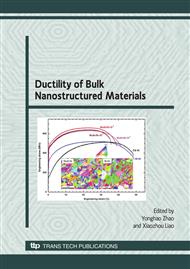[1]
D.G. Morris, in: Mechanical Behaviour of Nanostructured Materials, Trans. Tech. Publications Ltd., Switzerland, (1998).
Google Scholar
[2]
C.C. Koch, D.G. Morris, K. Lu and A. Inoue: Mater. Res. Soc. Bull. 24 (1999) 54.
Google Scholar
[3]
D. Jia, Y.M. Wang, K.T. Ramesh, E. Ma, Y.T. Zhao and R.Z. Valiev: Appl. Phys. Letts. 79 (2001) 611.
Google Scholar
[4]
Y. Wang, M. Chen, F. Zhou and E. Ma: Nature 419 (2002) 912.
Google Scholar
[5]
E. Ma: Scripta Mater. 49 (2003) 663.
Google Scholar
[6]
Y.M. Wang and E. Ma: Appl. Phys. Letts. 83 (2003) 3165.
Google Scholar
[7]
Q. Wei, L. Keeskes, T. Jiao, K.T. Hartwig, K.T. Ramesh and E. Ma: Acta Mater. 52 (2004) 1859.
Google Scholar
[8]
Y.M. Wang and E. Ma: Acta Mater. 52 (2004) 1699.
Google Scholar
[9]
R.Z. Valiev and T.G. Langdon: Prog. Mater. Sci. 51 (2006) 881.
Google Scholar
[10]
M. Dao, L. Lu, R.J. Asaro, J.T. M De Hosson and E. Ma: Acta Mater. 55 (2007) 4041.
Google Scholar
[11]
C.C. Koch: Scripta Mater. 49 (2003) 657.
Google Scholar
[12]
R.Z. Valiev: Mater. Sci. Eng. A234-236 (1997) 59.
Google Scholar
[13]
R.Z. Valiev, R.K. Islamgaliev and I.V. Alexandrov: Prog. Mater. Sci. 45 (2000) 103.
Google Scholar
[14]
H.W. Kim, S.B. Kang, N. Tsuji and Y. Minamino: Acta Mater. 53 (2005) 1737.
Google Scholar
[15]
S.V. Dobatkin, J.A. Szpunar, A.P. Zhilyaev, J. -Y. Cho and A.A. Kuznetsov: Mater. Sci. Eng. A462 (2007) 132.
Google Scholar
[16]
R.Z. Valiev, I.V. Alexandrov, Y.T. Zhu and T.C. Lowe: J. Mater. Res. 17 (2002) 5.
Google Scholar
[17]
B.Q. Han and T.G. Langdon: Mater. Sci. Eng. A410-411 (2005) 430.
Google Scholar
[18]
S. Cheng, Y.H. Zhao, Y.T. Zhu and E. Ma: Acta Mater. 55 (2007) 5822.
Google Scholar
[19]
Y.H. Zhao, X.Z. Liao, Z. Horita, T.G. Langdon and Y.T. Zhu: Mater. Sci. Eng. A493 (2008) 123.
Google Scholar
[20]
Y. Zhang, N.R. Tao and K. Lu: Acta Mater. 56 (2008) 2429.
Google Scholar
[21]
Y.S. Li, Y. Zhang, N.R. Tao and K. Lu: Scripta Mater. 59 (2008) 475.
Google Scholar
[22]
Y.H. Zhao, Y.Z. Guo, Q. Wei, A.M. Dangelwicz, C. Xu, Y.T. Zhu, T.G. Langdon, Y.Z. Zhou and E.J. Lavernia: Scripta Mater. 59 (2008) 627.
Google Scholar
[23]
M. Legros, B.R. Elliott, M.N. Rittner, J.R. Weertman and K.J. Hemker: Phil. Mag. A80 (2000) 1017.
Google Scholar
[24]
I. Gutierrez-Urrutia, M.A. Muñoz-Morris and D.G. Morris: Mater. Sci. Eng. A394 (2005) 399.
Google Scholar
[25]
I. Gutierrez-Urrutia, M.A. Muñoz-Morris and D.G. Morris: J. Mater. Res. 21 (2006) 329.
Google Scholar
[26]
I. Gutierrez-Urrutia, M.A. Muñoz-Morris and D.G. Morris: Acta Mater. 55 (2007) 1319.
Google Scholar
[27]
J. Wang, Y. Iwahishi, Z. Horita, M. Furukawa, M. Nemoto, R.Z. Valiev and T.G. Langdon: Acta Mater. 44 (1996) 2973.
Google Scholar
[28]
Y.H. Zhao, J.F. Bingert, Y.T. Zhu, X.Z. Liao, R.Z. Valiev, Z. Horita, T.G. Langdon, Y.Z. Zhou and E.J. Lavernia: Appl. Phys. Letts: 92 (2008) 081903.
DOI: 10.1063/1.2870014
Google Scholar
[29]
U.F. Kocks and H. Mecking: Prog. Mater. Sci. 48 (2003) 171.
Google Scholar
[30]
T. Hasegawa, T. Yakou and U.F. Kocks: Mater. Sci. Eng. 81 (1986) 189.
Google Scholar
[31]
I.A. Ovid´ko and A.G. Sheinerman: Acta Mater. 57 (2009) 2217.
Google Scholar
[32]
I. Sabirov, M.R. Barnett, Y. Estrin and P.D. Hodgson: Scripta Mater. (2009) in press.
Google Scholar
[33]
R. Lapovok, P.W.J. McKenzie, P.F. Thonson and S.L. Semiatin: Int. J. Mat. Res. 98 (2997) 325.
Google Scholar
[34]
Z. Horita, T. Fujinami and T.G. Langdon: Mater. Sci. Eng. A318 (2001) 34.
Google Scholar
[35]
C. Xu, Z. Szaraz, Z. Trojanova, P. Lukac and T.G. Langdon: Mater. Sci. Eng. A497 (2008) 206.
Google Scholar
[36]
D. J: Alexander and I.J. Beyerlein: Mater. Sci. Eng. A410-411 (2005) 480.
Google Scholar
[37]
M. Haouaoui, I. Karaman and H.J. Maier: Acta Mater. 54 (2006) 5477.
Google Scholar
[38]
W. Wei, K.X. Wei and G.J. Fan: Acta Mater. 56 (2008) 4771.
Google Scholar


